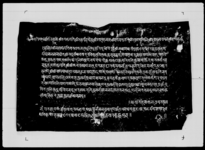A copper-plate decree of King Jayaprakāśa Malla prohibiting certain activities in various shrines of Kathmandu (NS 872)
ID: PN_0004_0049
Edited and
translated by Bal Gopal Shrestha and Ramhari Timalsina
in collaboration with
Manik Bajracharya
Created: 2016-06-27;
Last modified: 2017-09-28
For the metadata of the document, click here
The accompanying edition, translation/synopsis and/or commentary are available under the terms of the Creative Commons Attribution-ShareAlike 4.0 International License
Abstract
This copper plate document is a decree of King Jayaprakāśa Malla forbidding such activities as cutting down trees, killing both wild and domestic animals (e.g. reptiles and cows), and disturbing Brahmins and foreigners in various shrines of Kathmandu.Diplomatic edition
[1r]
1थ्वतिया,धर्म्मार्थया,साक्षि,श्री३पशुपति,श्री३स्वयंभूचैत्य,श्री३तलेजुमाजुश्री३देवगुतरे,श्री३वज्रयोगिनि,श्री३चगुनारायन,श्री३गौकर्ण्ण2\स्वस्ति।।श्रीमत्पशुपतिचरणकमलधूलिधूसरित,शिरोरुहश्रीमन्मानेश्वरीष्टदेवता,वलरद्ध,प्रसाददे
3दीप्यमानमानोन्नत,श्रीरघुवंशावतार,रविकुलतिलक,हनूमद्ध्वजनेपालेश्वर,महाराजाधिराजराज,रा
4जेन्द्र,सकलराज,चक्राधिश्वर,निजेष्टदेवदेवेश्वरी,कृपाकटा,क्षवनितवि,कमोपार्ज्जित,वारणाकर,स
5मुद्भूत,गजेद्रपति,श्रीश्रीजयप्रकाशमल,परमभट्टारकदेवानां,सदा,समर,विजयनां,प्रभुठाकुर
6सनओ,श्रीश्रीराजोपाध्या,परमान,उमराओ,भोट,योगि,देशान्तरि,महाविद्याधर,पञ्चसकलें,साहुतिमत
7याङाओ,आओनलि,ञदेशस,सुनानं,अन्याओयायमदु,स्वयभूचैत्ययागर,वालावु,गर,गौकर्ण्णगर,चगुग
8र,वज्रयोगिनियागर।।थ्वति,देवयास्थानयासिमा,गरसुनानंसिछकाषुनुछ्याङाओकायमदु।।सा,व्राह्मं
9अतित,पनिस्त,दुर्षवियमदुध्वर,माकरवि,सुनानं,स्यायमदु,खेल,वन,षण्ड,गनं,मितयमदु।।थन,मृगस्थ
10लीया,सिहर,सुद्धा,सुनानंकायमदु।।
11 ।। थ्व,पतिस,चोक्वन,उपरसुना
12 नं,यातसा,पञ्चमहापाप,राकजुरो,ग्वम्हसेनं,मानययात,ओम्हं,परमेश्वया,सुदृष्ट,राजदंदमोहो३२
13थ्वतिजुरो।।सम्वत्८७२आषाढशुद्वि१संक्रान्तिवुद्धवारकुन्हुशुभ।। ।।
Translation
[Synopsis]
The divine witnesses invoked for this religious decree are: thrice venerable Paśupati, thrice venerable Svayaṃbhū, thrice venerable Talejumāju, thrice venerable Devagutare, thrice venerable Vajrayogini, thrice venerable Cagunārāyana, thrice venerable Gokarṇṇa.
The decree provides a praśasti of King Jayaprakāśa Malla.
The main section of the decree writes that Lord Thākura and the twice venerable Rājopādhyāya, the chief officer (paramāna), commanders (umarāo), Tibetans, ascetics, foreigners, great wise men (mahāvidhyādhara), pañcas, and all assembled have agreed that from now on no one may commit injustice in the territory of Kathmandu (ña). No one may cut even a single piece of wood from the forests (gara) of Svayambhū, Bālābu, Gokarṇa, Cāṅgu and Vajrayoginī. No one must cause any trouble to cows, Brahmins or strangers. No one may kill jackals, monkeys or serpents. No fire may set in open grounds and forests. No one may even pluck leaves from trees at Mṛgasthalī. If anyone violates what has written in this plate will suffer [the same punishment as having] committed [any of] the five great sins, while the Almighty will look with favourable eyes upon those who obey them. The fine for violation is 32 moharas.
The date of the decree is Wednesday, Saṃkrānti, the 1st of the bright fortnight of Āṣāḍha in the [Nepāla Saṃvat] era year 872 (1752 CE).
Commentary
This copperplate, measuring 29 x 18.1 cm, is a copy of a royal proclamation by King Jayaprakāśa Malla.
Regmi 1966: 304-5 has a Devanāgarī transcription of a slightly different copper inscription he found at the temple of Vajrayoginī, Sankhu (see also Shrestha 2012: 394). Except for the absence of the sentence relating to Mṛgasthalī and Caṅgunārāyaṇa being referred to as Garuḍanārāyaṇa, everything is the same including the date inscribed in this copperplate. PN_0008_0020 is another document that replicates the content of this copperplate, while also providing a translation in the Nepali language to supplement the Nepalbhasa original, with everything in Devanāgarī script.
In all three variants, we find in the initial lines an invocation of Paśupati, Svayaṃbhū, Talejumāju, Devagutare, Vajrayoginī, Caṅgunārāyaṇa and Gokarṇa. This is followed by a glorification of the king, Jayaprakāśa Malla. The invocation and glorification are in Sanskrit, while the rest is in Nepalbhasa.

